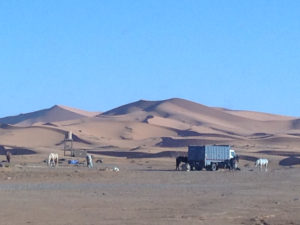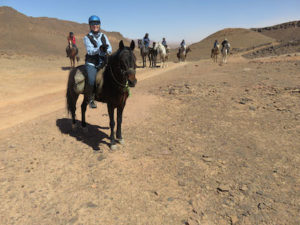
There were many in my inner circle that thought riding Arabian stallions in the Sahara was a bold move, me included. I have never been to Morocco, to an Islamic country, nor ridden a stallion, let alone through miles and miles of desert. As a leader, have you ever found yourself holding back from a good opportunity, a bold move, because of the perceived risk it includes?
I have to admit it never occurred to me that I couldn’t make this trip. By nature, I like a good challenge. But what made me feel that the risk was acceptable relative to the reward?
Risk Factors in Making Bold Moves
 First, I do long distance riding competitively so 120 miles in 6 days didn’t phase me. Second, I have had similar horseback adventures in other countries and found the guides are very knowledgeable and experienced in handling issues that arise. Finally, I just acquired an Arab myself and am enjoying getting to know the breed. The two remaining risk factors were the desert and the fact that the horses were stallions (known in USA to mean very volatile). In themselves, they didn’t rank very high on my fear meter.
First, I do long distance riding competitively so 120 miles in 6 days didn’t phase me. Second, I have had similar horseback adventures in other countries and found the guides are very knowledgeable and experienced in handling issues that arise. Finally, I just acquired an Arab myself and am enjoying getting to know the breed. The two remaining risk factors were the desert and the fact that the horses were stallions (known in USA to mean very volatile). In themselves, they didn’t rank very high on my fear meter.
At the time, I didn’t understand the real risk. it wasn’t until dinner in Quarzazate the night before our departure, as we sat around a large round table drinking mint tea and introducing ourselves to our fellow riding companions that the risk was framed for me by a young Brit in his 20’s. He stated his reason to be on the ride was to embrace the risk of going fast and to see if he could meet the challenge.
What he was referring to was the fact that this ride was positioned as a ride for experienced riders only. The riders are given several opportunities throughout the week to let their horses go flat out–top speed–as fast as they can fly over the desert. No other ride has allowed that–for many reasons– including terrain, rider capability and liability for what can go wrong. It is a bold move.
Accepting the Challenge and Taking the Risks
I knew at that moment that I would do it–I would ride like the wind–but not because I wanted the risk. In fact, my goal was to control the risk. Riding at high speed is dangerous in any circumstance; doing it on unfamiliar terrain with unfamiliar horses and unfamiliar riders can be life threatening. It was clear to me I needed to mitigate the risk to enable myself to participate in the bold move.
In fact, we had one serious injury. We were riding at a more controlled gallop when one of the horses stepped in deep sand, lost his balance and rolled right on top of a rider, breaking her collar bone. At a full out run it would have been even more serious.It didn’t deter me from my goal but made me very aware of the need to manage the odds of success.
Confidence Mitigates Risk
 So here is the lesson learned: Confidence mitigates risk and enables, if not encourages us, to make bold moves–whether it is personal or professional. Confidence emerges and gathers strength from research, planning, trial and contingency planning. Once defining the bold move you want to make, identify what you need to know or do to achieve the confidence necessary to minimize the risk of the move.
So here is the lesson learned: Confidence mitigates risk and enables, if not encourages us, to make bold moves–whether it is personal or professional. Confidence emerges and gathers strength from research, planning, trial and contingency planning. Once defining the bold move you want to make, identify what you need to know or do to achieve the confidence necessary to minimize the risk of the move.
Minimize the Risks
I took steps to minimize my risks, and so should you. Let me share with you the things you can do to minimize your risks, and how I did those things to minimize mine:
Parameters matter. Set yourself up to win! I asked for the right horse. We had not yet been assigned a horse and were given a chance to say what we wanted in our mounts. For me it was three things: a strong heart (in horse talk that means a mount that is not afraid and will push himself at the request of the rider or as a matter of pride); a soft eye (that is a friendly horse, one that is kind and often will protect his rider) and finally, a responsive horse that will go but also whoa. I was matched with Taissir–a real black beauty. He met 2 of the 3 criteria I was to learn later.
Experiment with the outcome. Run a beta. I didn’t assume I knew how my horse would behave. Hope is not a good predictor of outcome. I validated his whoa. If I was going to let him go I needed to know he had a whoa! Unlike my young friend, I wanted to control risk not embrace it! It may not be a surprise to learn that most horses that are ridden by hundreds of different riders are not trained with finesse and if they were once, inexperienced riders change that. Horses often behave only as well as their riders insist. The first day at a strong gallop (20mph) I got a taste of what the horse wanted. He accelerated past the group and started pulling away out in front. When the guide said whoa, his mind said go and he didn’t want to stop. Eventually, I was able to execute a one rein stop pulling with all of my might. I knew then I had my work cut out for me if I wanted to fly over the desert with Taissir.
 Develop programs that improve your odds of success By knowing where I was vulnerable–steering and stopping for instance–I was able to institute some plans that helped manage that vulnerability. Although Taissir was a very forward moving horse–he walked out with speed and preferred to lead–we went to the back of the pack on day 2. We went the pace I wanted, I never let him take the lead. I managed his speed and made him listen to me. When we did canter, it was at a slower speed and even on a looser rein. We agreed to work together and both became more relaxed and comfortable together.
Develop programs that improve your odds of success By knowing where I was vulnerable–steering and stopping for instance–I was able to institute some plans that helped manage that vulnerability. Although Taissir was a very forward moving horse–he walked out with speed and preferred to lead–we went to the back of the pack on day 2. We went the pace I wanted, I never let him take the lead. I managed his speed and made him listen to me. When we did canter, it was at a slower speed and even on a looser rein. We agreed to work together and both became more relaxed and comfortable together.
Avoid potential potholes. That was true literally and figuratively for me. Bold moves are usually offensive plays but that doesn’t mean defense isn’t important. For me that meant being sure I scoped the terrain ahead and left it to Taissir to manage the immediate footing. I was on the lookout for places we could mis-step or riders that would inadvertently create hazards. We wanted to be fast but we needed to be nimble–and be able to steer or stop on a moment’s notice. I rode defensively while letting Taissir manage our offense–pour on the speed but be ready to stop. It reminds me of the adage “Expect the best but be prepared for the worst.” By recognizing what might go wrong we go a long way toward preventing it.
Gallop with Confidence
In the end, I was able to gallop with great confidence. My highest recorded speed in conditioning my own horse was 28 mph. Not quite top speed but close. Now, in the desert on an unfamiliar horse, I clocked at 30 mph. It was quite a thrill–and bold–but I had considerable confidence given the preparation.
What Step Will Free You to Make Your Bold Move?
Some of the very best growth opportunities–in life and business–come from bold moves. Don’t let risk deter you; manage it so that you have the confidence to proceed. In my case, I needed to know I could stop before going flat out. What action will allow you to embrace your bold move?
